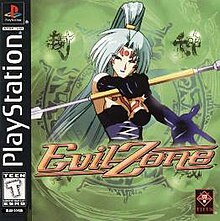Evil Zone
This article may require copy editing for grammar, style, cohesion, tone, or spelling. (March 2021) |
| Evil Zone | |
|---|---|
 | |
| Developer(s) | Yuke's Future Media Creators |
| Publisher(s) |
|
| Platform(s) | PlayStation |
| Release | |
| Genre(s) | Fighting |
| Mode(s) | Single-player, multiplayer |
Evil Zone[a], stylized as EVIL Z♀NE in the PAL region, is a fighting game developed by Yuke's Future Media Creators for the PlayStation in 1999. The player can choose from ten characters to fight in several game modes including story mode, arcade mode, versus mode, practice and survival mode.
Story
The story of the game tells of Ihadurca, a powerful being who exists in multiple dimensions at once. The inhabitants of the world of I-Praseru (Happy Island) were able to temporarily confine Ihadurca in a dimension known as Evil Zone.
Now, a tournament is being held to select the strongest warrior throughout the dimensions. The champion tasked to destroy Ihadurca before she can escape the Evil Zone and threaten the world once more.
The story mode is presented as an anime. Every playable character has their own unique story, each including their own unique title, and cutscenes (narrated by the playable character). Every cutscene is animated in an anime style and was drawn externally by animation studio AIC.
Gameplay
During gameplay, fighting occurs on a 3D field, with characters allowed to move forwards, backwards, and sidestep left and right. Most of the fighting is done with range-based attacks, but it is possible to attack a short-range and use grapple moves on your opponent. The fighting system only utilizes two main moves types: attack and guard.
Each playable character has a unique move set and ultra-attack. An ultra-attack is a powerful move that requires ‘Power Stocks’ to perform. A character’s ultra-attack can last up to 20 seconds long, even longer if it is delt as the finishing blow.
‘Power Stocks’ are obtained by holding both the directional down and attack buttons. This can be charged to up to three stocks at a time. The less health a character has, the faster it takes to charge.
A ‘Pressure Dash’ can occur if both characters perform a dash attack, towards each other, at the same time. If a ‘Pressure Dash’ occurs, each player must rapidly hit buttons to gain an advantage over their opponent.
Reception
| Aggregator | Score |
|---|---|
| GameRankings | 62%[2] |
| Publication | Score |
|---|---|
| AllGame | |
| Computer and Video Games | |
| Electronic Gaming Monthly | 5.25/10[5] |
| Famitsu | 27/40[6] |
| Game Informer | 5/10[7] |
| GameFan | 63%[8] |
| GameSpot | 7.6/10[9] |
| IGN | 4/10[10] |
| PlayStation Official Magazine – UK | 6/10[11] |
| Official U.S. PlayStation Magazine |
The game received mixed reviews according to the review aggregation website GameRankings.[2] In Japan, Famitsu gave it a score of 27 out of 40.[6]
Notes
References
- ^ GameSpot staff (July 21, 1999). "PlayStation Evil Zone Ships [date mislabeled as "April 27, 2000"]". GameSpot. CBS Interactive. Archived from the original on January 17, 2000. Retrieved November 12, 2020.
- ^ a b "Evil Zone for PlayStation". GameRankings. CBS Interactive. Archived from the original on May 1, 2019. Retrieved November 12, 2020.
- ^ House, Matthew. "Evil Zone - Review". AllGame. All Media Network. Archived from the original on November 16, 2014. Retrieved November 12, 2020.
- ^ "Review: Evil Zone". Computer and Video Games. No. 212. Future Publishing. July 1999.
- ^ EGM staff (October 1999). "Evil Zone". Electronic Gaming Monthly. No. 123. Ziff Davis.
- ^ a b "封神領域エルツヴァーユ [PS]". Famitsu (in Japanese). Enterbrain. Retrieved November 12, 2020.
- ^ Reiner, Andrew (October 1999). "Evil Zone". Game Informer. No. 78. FuncoLand. Archived from the original on June 5, 2000. Retrieved November 12, 2020.
- ^ Ngo, George "Eggo"; Chau, Anthony "Dangohead"; Rodriguez, Tyrone "Cerberus" (September 1999). "Evil Zone". GameFan. Vol. 7, no. 9. Shinno Media. p. 16. Retrieved November 12, 2020.
- ^ Mielke, James (February 11, 1999). "Evil Zone Review [Japan Import] [date mislabeled as "April 28, 2000"]". GameSpot. CBS Interactive. Retrieved November 12, 2020.
- ^ Cleveland, Adam (July 29, 1999). "Evil Zone". IGN. Ziff Davis. Retrieved November 12, 2020.
- ^ Wilton, Pete (July 1999). "Evil Zone". Official UK PlayStation Magazine. No. 47. Future Publishing. p. 90. Retrieved November 12, 2020.
- ^ Maruyama, Wataru (October 1999). "Evil Zone". Official U.S. PlayStation Magazine. Vol. 3, no. 1. Ziff Davis. p. 132. Retrieved November 12, 2020.
External links
- Wikipedia articles needing copy edit from March 2021
- 1999 video games
- 3D fighting games
- Anime International Company
- Multiplayer and single-player video games
- PlayStation (console) games
- PlayStation (console)-only games
- Science fantasy video games
- Titus Software games
- Video games about demons
- Video games developed in Japan
- Video games featuring female antagonists
- Video games featuring female protagonists
- Video games featuring parallel universes
- Video games scored by Satoshi Miyashita
- Video games with alternate endings
- Yuke's games
